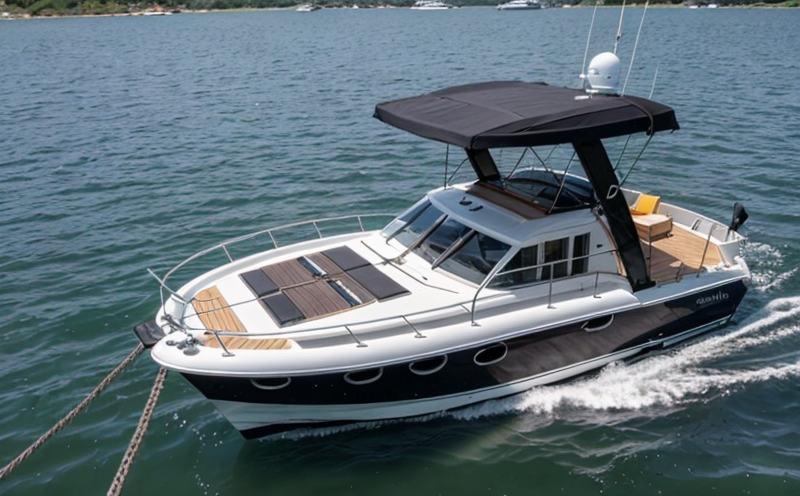ASTM D885 Testing of High-Tensile Polyester Mooring Ropes
The ASTM D885 standard specifies procedures for determining the tensile properties and elongation characteristics of high-tensile polyester yarns, which are commonly used in mooring ropes. This testing is critical in ensuring the reliability and safety of marine equipment that relies on these ropes. The primary focus is to evaluate how the material performs under controlled stress conditions simulating real-world scenarios such as tension during anchor deployment or ship maneuvering.
For high-tensile polyester yarns, which are a key component in mooring ropes, this test ensures compliance with international standards and regulatory requirements. By adhering to ASTM D885, manufacturers can demonstrate that their products meet the necessary performance criteria for durability and safety. The testing process involves carefully preparing samples of the material according to specified dimensions and ensuring they are free from defects or contamination.
The tensile properties measured include ultimate tensile strength (UTS) and elongation at break, which provide critical data on how the rope will behave under stress. Understanding these parameters is essential for predicting the lifespan of mooring ropes in marine environments where exposure to saltwater can significantly affect material performance over time.
The ASTM D885 method uses a specialized tensile testing machine capable of applying controlled loads and measuring strain accurately. This equipment allows for precise control over test conditions, including temperature and humidity, which are important factors affecting the behavior of polyester materials. After conducting tests according to the standard, detailed reports are generated that include all relevant data points along with graphical representations of how the material responded during testing.
The importance of this type of testing cannot be overstated when it comes to ensuring maritime safety and compliance with regulatory requirements set forth by organizations like the International Maritime Organization (IMO). By performing ASTM D885 compliant tests, manufacturers can ensure their products are not only meeting but exceeding industry expectations for reliability and performance.
It's worth noting that while ASTM D885 covers polyester yarns specifically, its principles apply more broadly to other synthetic fibers used in marine applications. The ability to accurately measure tensile strength and elongation is crucial across various sectors within the maritime industry where similar materials are employed.
International Acceptance and Recognition
The ASTM D885 standard for testing high-tensile polyester mooring ropes has gained widespread international recognition due to its rigorous methodology and consistent results. This acceptance is reflected in the fact that many global organizations, including the International Organization for Standardization (ISO) and the International Maritime Organization (IMO), reference this standard as a best practice for ensuring quality control within the maritime industry.
Many countries have adopted ASTM D885 as part of their national standards for marine equipment testing. For instance, the European Union has incorporated aspects of the standard into its directives on product safety and environmental protection. Similarly, shipping companies around the world rely on this standard to verify that the mooring ropes they purchase meet specified performance levels.
The international recognition extends beyond mere adoption; it also includes participation in developing new versions of the standard through collaboration between experts from various regions. This collaborative approach ensures that the testing method remains relevant and effective as technologies evolve within the maritime sector. Organizations such as Lloyd's Register and DNV GL have endorsed ASTM D885, further cementing its status as a benchmark for quality control.
The global acceptance of ASTM D885 underscores its importance not only for manufacturers but also for end-users who depend on reliable mooring ropes to protect their assets. By adhering to this standard, companies can gain trust from customers and regulators alike while maintaining high standards of product integrity.
Environmental and Sustainability Contributions
- Moorings play a crucial role in reducing the environmental impact associated with shipping activities by enabling ships to remain stationary without constant engine operation or anchoring.
- The use of polyester ropes, which are recyclable and made from renewable resources like terephthalic acid derived from petroleum products, contributes positively towards sustainable practices within the maritime industry.
ASTM D885 testing supports these sustainability efforts by providing data that helps manufacturers improve their production processes to enhance rope durability while minimizing waste. Additionally, understanding the environmental factors affecting polyester ropes allows for better decision-making regarding material selection and lifecycle management strategies aimed at reducing overall carbon footprints.
By ensuring compliance with ASTM D885 standards during manufacturing, companies contribute to longer-lasting products that require less frequent replacement, thus extending their operational life on ships. This reduces the need for excessive resource consumption throughout the supply chain, promoting a more sustainable approach to maritime operations.
Use Cases and Application Examples
| Application | Description |
|---|---|
| Mooring Rope Testing | Determining the tensile strength and elongation properties of high-tensile polyester mooring ropes to ensure they meet required standards for safety and durability. |
| Quality Assurance | Performing ASTM D885 tests as part of a comprehensive quality assurance program to verify product performance against specified criteria before release into the market or use aboard ships. |
| Regulatory Compliance | Ensuring compliance with international standards for marine equipment by conducting ASTM D885 testing on mooring ropes used in various maritime operations. |
The ASTM D885 test is widely utilized across different sectors within the maritime industry. For instance, shipyards and fleet operators use these results to select appropriate mooring ropes that can withstand the harsh conditions encountered during port calls or ocean voyages. Additionally, research institutions often conduct comparative studies using ASTM D885 data to develop improved materials for future applications.
Real-world examples include naval vessels where precise control over mooring forces is crucial due to limited maneuverability in tight harbors. In these cases, the ability to accurately predict rope performance under various loading conditions directly translates into safer operations and reduced maintenance costs associated with premature failure or damage.





